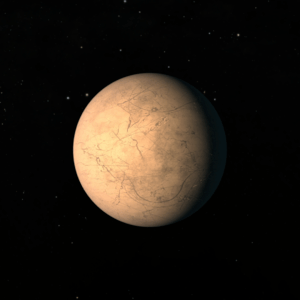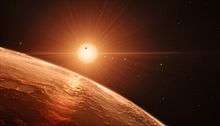TRAPPIST-1h
| Exoplanet | List of exoplanets | |
|---|---|---|
 | ||
| Parent star | ||
| Star | TRAPPIST-1[1] | |
| Spectral type | M8[1][2]:1236 | |
| Mass | (m) | 0.08 (± 0.009) (± 0.02)[1] M☉ |
| Radius | (r) | 0.117 (± 0.004)[1] R☉ |
| Temperature | (T) | 2550.0 (± 55.0)[1] K |
| Age | 3-8 Gyr | |
| Orbital elements | ||
| Semi-major axis | (a) | 0.063 ( −0.013 +0.027 )[1] AU |
| Eccentricity | (e) | 0.086 [3] |
| Orbital period | (P) | 18.764+0.008 −0.009[3] d |
| Inclination | (i) | 89.8 ( −0.05 +0.1 )[1]° |
| Physical characteristics | ||
| Mass | (m) | 0.086[4] M⊕ |
| Minimum mass | (m sin i) | 0.002[3] M⊕ |
| Maximum mass | (m sin i) | 0.17[3] M⊕ |
| Radius | (r) | 0.715+0.047 −0.043[3] R⊕ |
| Stellar flux | (F⊙) | ~0.15 ⊕ |
| Temperature | (T) | 169 K (−104 °C; −155 °F)[3] |
| Discovery information | ||
| Discovery date | 2017 | |
| Discoverer(s) | ||
| Discovery method | Transit | |
| Discovery status | Published | |
TRAPPIST-1h, also designated as 2MASS J23062928-0502285 h, is an exoplanet orbiting around the ultra-cool dwarf star TRAPPIST-1 39 light-years (12 parsecs) away from Earth in the constellation Aquarius. It was one of four new exoplanets to be discovered orbiting the star using observations from the Spitzer Space Telescope.[5][6]
Characteristics
Mass, radius, and temperature
TRAPPIST-1h is an Earth-sized exoplanet, meaning it has a mass and radius close to that of Earth. Like TRAPPIST-1d, it is intermediate between the sizes of Mars and Earth. The amount of light blocked by the host star shows that TRAPPIST-1h has a radius of about 0.715 R⊕. Transit timing variations also give a mass of around 0.086 ± 0.084 M⊕. These two values make TRAPPIST-1h the smallest of all the planets in its system. The planet's density is around 1.297 ± 1.266 g/cm3, and its gravity is only around 0.168 times that of Earth, similar to the gravitational pull of the Moon. It has an equilibrium temperature of 169 K (−104 °C; −155 °F), similar to that of Earth's south pole.
Host star
The planet orbits an (M-type) ultracool dwarf star named TRAPPIST-1. The star has a mass of 0.08 M☉ and a radius of 0.11 R☉. It has a temperature of 2550 K and is between 3 and 8 billion years old. In comparison, the Sun is 4.6 billion years old and has a temperature of 5778 K. The star is metal-rich, with a metallicity (Fe/H) of 0.04, or 109% the solar amount. This is particularly odd as such low-mass stars near the boundary between brown dwarfs and hydrogen-fusing stars should be expected to have considerably less metal content than the Sun. Its luminosity (L☉) is 0.05% of that of the Sun.
The star's apparent magnitude, or how bright it appears from Earth's perspective, is 18.8. Therefore, it is too dim to be seen with the naked eye.
Orbit
TRAPPIST-1h orbits its host star with an orbital period of 18.764 days and an orbital radius of about 0.063 AU (compared to the distance of Mercury from the Sun, which is about 0.38 AU).[3]
Might host water
Although TRAPPIST-1h is at the snow line it could harbor liquid water[7][8] under an H2-rich atmosphere, either primordial or resulting from continuous outgassing combined with internal heating.[3] If not, then it could harbor a subsurface ocean powered by underground volcanoes, if it is an icy planet.
See also
References
- 1 2 3 4 5 6 7 "Planet TRAPPIST-1 h". Exoplanet.eu. Retrieved 2017-02-22.
- ↑ Costa, E.; Mendez, R.A.; Jao, W.-C.; Henry, T.J.; Subasavage, J.P.; Ianna, P.A. (August 4, 2006). "The Solar Neighborhood. XVI. Parallaxes from CTIOPI: Final Results from the 1.5 m Telescope Program" (PDF). The Astronomical Journal. The American Astronomical Society. 132 (3): 1234. Bibcode:2006AJ....132.1234C. CiteSeerX 10.1.1.622.2310. doi:10.1086/505706.
- 1 2 3 4 5 6 7 8 Luger, Rodrigo; Sestovic, Marko; Kruse, Ethan; Grimm, Simon L.; Demory, Brice-Olivier; et al. (2017). "A terrestrial-sized exoplanet at the snow line of TRAPPIST-1". Nature Astronomy. 1: 0129. arXiv:1703.04166 [astro-ph.EP]. Bibcode:2017NatAs...1E.129L. doi:10.1038/s41550-017-0129. Cite uses deprecated parameter
|class=(help) - ↑ Gillon, M.; Triaud, A. H. M. J.; Demory, B.-O.; et al. (February 2017). "Seven temperate terrestrial planets around the nearby ultracool dwarf star TRAPPIST-1" (PDF). Nature. 542 (7642): 456–460. arXiv:1703.01424. Bibcode:2017Natur.542..456G. doi:10.1038/nature21360. PMC 5330437. PMID 28230125.
- ↑ "Temperate Earth-Sized Planets Found in Extraordinarily Rich Planetary System TRAPPIST-1". SpaceRef. 22 February 2017. Retrieved 11 February 2017.
- ↑ "NASA telescope reveals largest batch of Earth-size, habitable-zone planets around single star". Exoplanet Exploration: Planets Beyond our Solar System (Press release). Retrieved 22 February 2017.
- ↑ Bourrier, Vincent; de Wit, Julien; Jäger, Mathias (31 August 2017). "Hubble delivers first hints of possible water content of TRAPPIST-1 planets". www.SpaceTelescope.org. Retrieved 4 September 2017.
- ↑ PTI (4 September 2017). "First evidence of water found on TRAPPIST-1 planets - The results suggest that the outer planets of the system might still harbour substantial amounts of water. This includes the three planets within the habitable zone of the star, lending further weight to the possibility that they may indeed be habitable". The Indian Express. Retrieved 4 September 2017.

